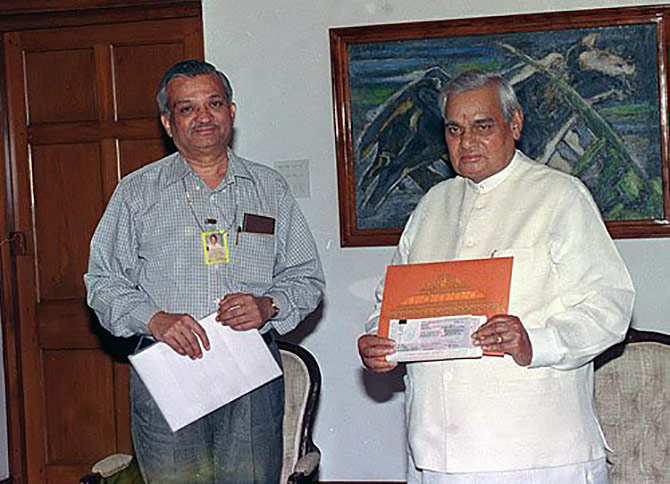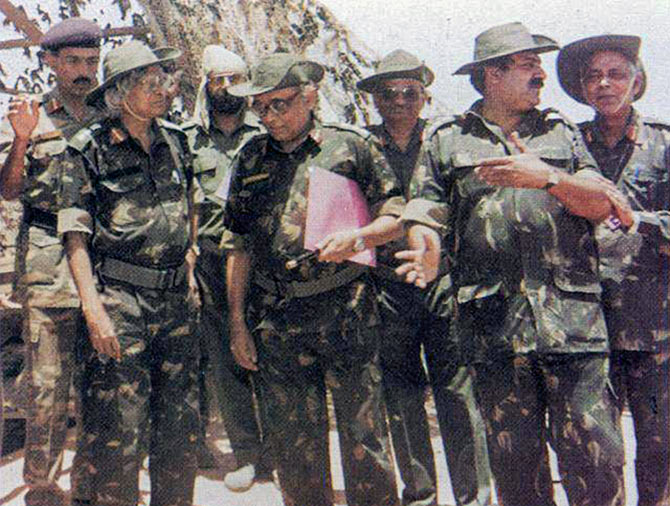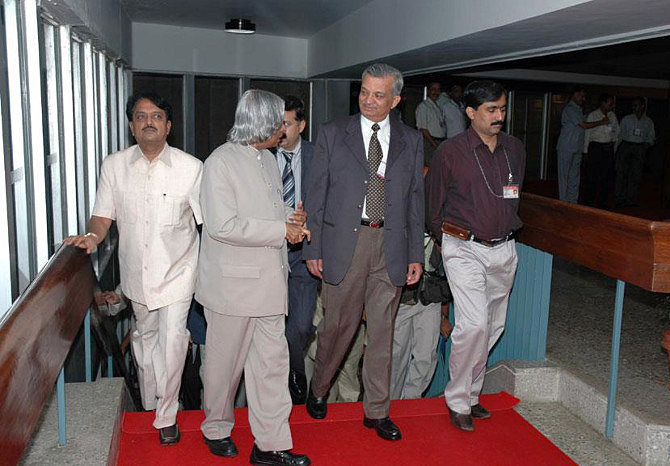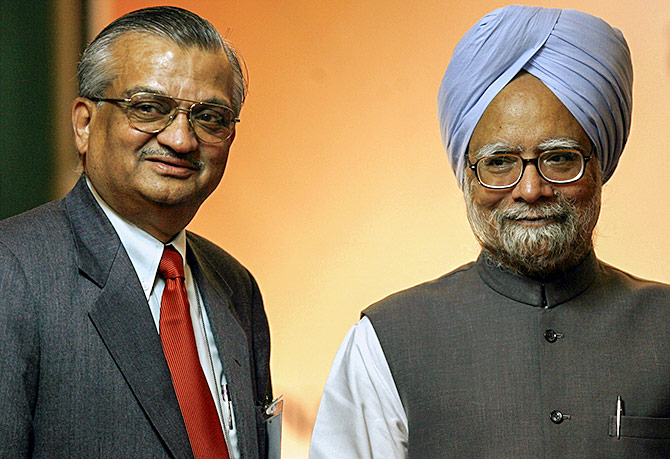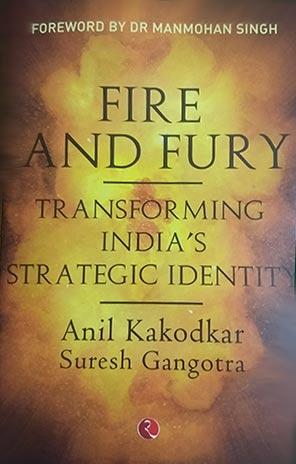Frontiersman
(Excerpts of this obituary appeared in Business India magazine Nov 30-Dec 13, 2020
(Rediff.com is publishing this obituary tribute in instalments: 1) https://www.rediff.com/business/special/fc-kohli-the-visionary-who-made-indian-it-industry-global/20201202.htm 2) https://www.rediff.com/business/special/how-f-c-kohli-and-tcs-conquered-the-world/20201207.htm )
Faqir Chand Kohli was a frontiersman literally and metaphorically.
He was
born as the youngest son of Gobindram Kohli and Bhagwanti Devi on March 19,
1924 in Peshawar, North West Frontier Province of undivided India (now part of
Khyber Pakhtunkhwa in Pakistan) . Gobindram Kohli was a self made businessman
who started small and grew a prosperous drapery and clothing business,
"Kriparam Drapers" in Peshawar Cantonment that became the most
reputed and sought after firm in North India for various types of European
clothing. It had a large clientele consisting of officers of the British
military and Civil Services as well as Indian elite.
His
eldest brother Devraj Kohli mentored him and encouraged him to take academics
seriously. When Kohli topped his Matriculation from the NWFP his brother pushed
him to join Government College, Lahore, then a cradle of higher education in
North India. The alumni list of Government College Lahore reads like the
"who's who" of the Indian subcontinent of 20th century in films,
literature, politics, military as well as in civil services.
He was
keen to get a masters in Power Engineering so took permission from the
Government of India and stayed back. He self financed his study at MIT,
Cambridge, Massachusetts for a Masters in Power Engineering. There he was also
exposed to the new fangled subject of System Engineering which grew during WWII.
MIT was a pioneer in introducing a course at MS level in System Engineering and
Control Systems. Knowledge hungry Kohli took full advantage.
This early
exposure to System Engineering at MIT had a far reaching influence on Kohli's
thinking in the rest of his engineering career.
On
completing his masters at MIT, he was surprised to find a suggestion by Indian
Government representatives in US to consider joining Tata Electric Companies which
was a private sector company that had pioneered electricity generation,
transmission and distribution in Bombay, Pune, and surrounding cities of Thane,
Kalyan etc.
He
accepted the suggestion though he did not know much about Tata Group at that
time and joined Ebasco International, in New York. Ebasco were then a leading
consulting company for power projects in North and South America and were also
technical Managing Agents for Tata Electric Companies at Bombay. He had
intensive practical training with them in New York, Connecticut, Massachusetts
etc. before leaving for India in 1951.
While he was pursuing higher education in North America his family had lost all their property and business during partition and had moved to Lucknow and Delhi. The mayhem and anarchy of partition shocked him and hurt him deeply since he had seen a different peaceful coexistence and friendship between Hindus, Sikhs and Muslims both at Peshawar and Lahore all his life till he left for North America in 1944.
But
the Kohlis were a forward looking family without wasting energy in anger, self
pity and nostalgia. He took heart from the positive attitude of his mother and
elder brother and mentor and plunged himself in the new life at Tata Electric
Companies, Mumbai. He spent long hours at Kalyan, Khopoli, Lonavala, Parel,
Dharavi learning all about the hydroelectric generating stations, load dispatch
centre, receiving stations and at the head office in Bombay House near today's
Hutatma Chowk in south Mumbai. He was given the task by engineers at Ebasco
International stationed at Mumbai to modernise Load Dispatch after learning
everything about the entire generation, transmission and distribution system as
well as the practices at Tata Electric.
He did
an admirable job of it and the proof of the pudding is in the high quality
(stable voltage and fixed frequency) of uninterrupted power that Mumbai City
gets for the last five decades or more. It has been rated by many power
aficionados as equal to or better than that of New York City.
Tata
Electric was already a tech savy company before Kohli entered it. For example
when North America was using 64 KV transmission lines Tata Electric was using
110 KV and General Electric had to manufacture appropriate circuit breakers
specially for Tata Electric and so on.
While at Tata Electric, in the '50s Kohli was introduced to another power engineer and passionate educationist, P K Kelkar. Kelkar was then the principal of VJTI, the top engineering college in Mumbai. Kohli immediately involved himself in engineering education which lasted his lifetime. He pioneered the first course in System Engineering and Control Systems at VJTI at MTech level in 1956 lecturing there during the weekend. Kelkar and Kohli's friendship evolved and when Kelkar was called upon by the Government of India to first establish Indian Institute of Technology Bombay and later Indian Institute of Technology, Kanpur; Kohli was enthusiastically by Kelkar's side and actively scouted abroad recruits to the faculty of electrical engineering both at IIT Bombay and IIT Kanpur.
It is well known that IITs have played a major role in the IT revolution in India as well as in the Silicon Valley. Indeed many engineers that joined Kohli at TCS later in the 70s were IIT Bombay and IIT Kanpur products and so also were N R Narayanamurthy and Nandan Nilekani who founded Infosys in the 80s.
As engineering education and Computer Science proliferated in the last 30 years the the quantitative out put was explosive but the quality of graduates left much to be desired. Kohli and his team at TCS hence broadedend their interaction from IITs and IIMs to over 200 engineering colleges and involved themselves in faculty development, curriculum modernisation, R&D collaboration and sponsorship etc. etc. Some cynics might call this mere supply chain management but the concrete impact of the Academic Interaction Program of TCS has been salutory on engineering education.
While still at Tata Electric, knowledge hungry Kohli enroled himself for a course at IITK for computer programming in 1963 when IITK acquired its first IBM 1620 computer. Later in 1964 when TIFR (Tata Institute of Fundamental Research), Mumbai brought in a CDC 3600 mainframe computer as a central computing facility not only for its scientists but also for outside users as a time sharing facility, Kohli enroled many of his colleagues from Tata Electric for courses in programming at TIFR. Between 1964 and 1966, Tata Eletcric became the biggest single user of the main frame computer at TIFR for all its needs consuming as much as 25% of Computer time. In 1966 Tata Electric persuaded the Central Water and Power Commission to allow it to import a computer exclusively for its own use and became the first power company in Asia and only the third in the world to use a digital computer for Load Dispatch and other network management issues.
After having studied the issues regarding power transmission in Mumbai and India he wrote a technical paper in 1961 in IEEE Journal, recommending that in order to build a national power grid the government should invest in 400KV or 500KV transmission lines to achieve maximum efficiency and economy. The result is what we see today as PGCIL (Power Grid Corporation of India).
Till recently seeing the problems in Indian power sector and especially
the enormous wastage in transmission and distribution losses he mooted time and
again that nation's top power engineering academics at IITs, IISc etc should
setup a consulting group to help the state and central organisations in the
power sector. He kept in touch with bright IIT faculty in the subject even in
his 90s.
Thus the frontiersman remained at the frontier of power engineering.
Kohli
also pushed for the creation of a community of engineers to solve both technical
and societal problems. He actively associated himself with the largest and the
most prestigious such organisation of professional engineers in the world, IEEE
(Institute of Electrical and Electronics Engineers), which has today nearly 500,000
members worldwide. He worked tirelessly to expand IEEE activities and
membership in India. This helped Indian engineers and engineering students and
faculty enter the global arena on equal intellectual footing with their global
peers. IEEE honoured him with its prestigious Founders Medal in 2012. The first
Indian to be thus honoured.
After
seeing Kohli's pioneering adoption of computers to power engineering, J R D
Tata, Nani Palkhivala and P M Agrawala invited Kohli to join the fledgling TCS
in 1969.
One should appreciate the sagacity and audacity of JRD and Palkhivala in founding TCS as a division of Tata Sons on April 1, 1968. At that time there was no Microsoft or Intel, SAP or Accenture, much less Google et al. Hewlett Packard whose evolution near Palo Alto, California seeded the birth of the Silicon Valley, was then a lab equipment making company producing oscilloscopes and oscillators.
In this situation the founders of TCS were dreaming of bringing
the benefits of Computers, to Indian society and economy. They wanted TCS to
develop applications using the computers made by a handful of companies viz
IBM, Digital Equipment, Burroughs and ICL (UK).
JRD
and Palkhivala were business visionaries but not techies. They needed a person
who could build and execute their vision: a frontiersman; a problem solver and
an institution builder.
It was
their and India's good fortune that Faqir Chand Kohli more than measured up to
their requirements and indeed laid the foundation to take TCS to unimaginable
heights and to the giant success that it is today. In that process he helped create
the technique, the systems, human resources and the ecosystem of a whole
Industry that has caught the rest of the nations by surprise and admiration and
envy.
Today
in the world of global business India is a synonym for IT services. Indian IT industry
is nearing $200 billion in size and it is Indian IT services exports that are
virtually financing our growing oil and other imports.
By far
the biggest achievement of Kohli has been the building of TCS (Tata Consultancy
Services) which is today neck and neck with Accenture and the fabled IBM in
terms of number of engineers working in it (nearly half a million) as well as in
market valuation. TCS is the unrivalled Jewel in the Crown of Tata Group.
However when Kohli took over TCS, it had completed one year with not much to show. It had a dozen consultants and had made a loss of a few lakhs. Clearly there were not many takers for computer services in India in 1968-69. According to an apocryphal story of that period, when Kohli first entered TCS he did not find his colleagues in the office at Nariman Point. Puzzled but shrewd Kohli went outside a popular movie theatre opposite Churchgate station at Matinee timings and lo and behold he saw the entire consulting staff emerging from it after the show !
From
those early days in 1969, brick by brick Kohli built a team of techies;
recruited bright engineers, Chartered Accountants, science and math
postgraduates, as a matter of fact anyone who looked smart and hard working
enough to his sharp gaze. Then he went looking for prospective clients in
Mumbai and rest of India: telephone companies looking for a better Directory;
Universities looking for faster exam results and mark sheets; utilities
struggling with billing their thousands of consumers; banks and insurance
companies struggling to manage their ledgers and reconciliation; anyone looking
for help in accounting and payroll etc etc. He used a couple of ICL machines
which were already in Tata fold. As work started flowing in, TCS needed the
newer and more powerful machines.
At that time IBM was already entrenched in India selling and leasing their machines to academia and government, shrewd Kohli looked for a new partner and he found it in Burroughs which at that time had no presence in India and also had a technically better machine than IBM and was looking to expand. The first obstacle he found was the forex starved government trying to recover from 50% devaluation of Indian rupee vis a vis dollar at World Bank's behest in 1966-67 and per force did not encourage anyone importing expensive computers.
After
intensive lobbying the government provisionally approved Kohli's request provided
TCS earned more foreign exchange than what it paid to import the computer. Thus
started TCS' outward journey, while keeping its feet firmly on Indian
ground.
Kohli
started scouting the world market in developed and developing countries
charming his way into senior executives' offices flashing his MIT and IEEE credentials,
trying to convince them that his team of bright engineers and programmers in
India could help their businesses achieve better efficiency using computers.
And if they are already using computers then TCS could write new software
solutions or fix problems in old ones etc etc.
If the client preferred to see TCS in action in front of his eyes then Kohli was ready to send his best and brightest abroad to client sites and if he could charm them to agree to outsource the project to India with a guarantee of satisfactory completion, in time and within budget, thereby cutting costs to both parties then all the better and so on.
How did Kohli go about solving the problem of large project execution or scaling up business ? Here he ingeniously applied his knowledge of System Engineering gained at MIT two decades earlier. He realised that programming was an essentially artisan like activity. Each programmer had his own logic and way of devising the solution, it was not a team effort, it could not be replicated and it could not even be fixed or improved by a different person.
So the
challenge was to industrialise software development. It involved setting up
programming standards, quality standards, modular architecture, breaking the
problem into components that could be developed by several people
simultaneously, readymade libraries of software components, automating
some aspects of software development and maintenance and so on and so forth.
This later came to be known as software engineering.
Extending the lessons of 300 year old manufacturing; amply demonstrated by Henry Ford's assembly line and Toyota's Just in Time and distributed manufacturing and co-engineering etc to software development, Kohli and his able team of lieutenants rubbed shoulders with global giants like IBM and showed their mettle in setting up the entire ecosystem in house.
Today
every IT company of the world wants to hire Indian talent not because of labour
arbitrage but because of the unparalleled quantity and quality of software
engineering talent. In a way what Kohli and TCS innovated and which Indian IT
industry adopted has been a disruptive business innovation in Global IT. The
late Clayton Christensen who coined the term "disruptive innovation" at
Harvard Business School much later would certainly nod his admiration and
approval from the heavens.
In the
last two decades China opened up its doors to TCS and other Indian IT
companies and rolled out the red carpet, precisely to learn from them and get
their Chinese software engineers trained. The author was eye witness to Chinese
PM, Wen Jiabao admitting as much when he visited TCS office in Bengaluru in April
2005.
Interestingly Kohli not only learnt certain concepts from manufacturing and brought them into IT services but also firmly believed that manufacturing will be further revolutionised by IT. Hence when JRD, Palkhivala and Kohli decided to establish an R&D centre for TCS in 1981 they wanted it to be different from the existing R&D centres in the public or private sectors. Tata Research Design & Development Centre (TRDDC) which was thus established at Pune, had not only a software engineering group headed by Kesav Nori, but the over all director was E C Subbarao a renowned material scientist. Thus Kohli encouraged research and development into manufacturing, material science side by side with software engineering. TRDDC came up with several innovations in Tata Steel, Hindustan Zinc, Hindustan Copper and the cement industry besides a veritable arsenal of software tools that were the envy of IT pioneers like IBM.
This work to lay the foundation of Indian IT services took TCS about 25 years. Then in the early nineties Kohli spotted a once in a lifetime opportunity; the impending Y2K problem for global users of computers. All major computer users: Air Lines, Utilities, Banks, stock exchanges, global corporations etc etc wanted to make sure that all their computer software will continue to work as before when the clock struck 12:00:01 am on 1st Jan 2000. There were fears that the computers would go to potentially disastrous 1 Jan 00 and not 1 Jan 2000. To be hundred percent sure of smooth business continuity billions of lines of computer programs had to be checked. And that too well in advance of the beginning of the new millennium.
Many
business historians have noted that correcting this code led to spurt in TCS
revenue and also of other Indian IT companies big and small. But few know that
TCS alone processed over 700 million lines of code in 2-3 years that is almost
30% of global code. However the secret of TCS success in this too is due to ingenious
System Engineering and Software Engineering that Kohli and his proteges S
Ramadorai, S Mahalingam and R&D head Kesav Nori applied to the problem.
TCS
developed software tools that scanned any program that was fed to them, automatically
found where the date field appeared and changed it to four digits while making
sure of the integrity of the rest of software so that after 1999 which appeared
in the old code as 99 it would not become 00 but correctly 2000. Equipped with such
in house software automation tools developed by the team at TRDDC (Tata Research Design and Development Centre), their R&D centre at Pune, they set
up a Software Factory in Chennai and achieved to the clients' satisfaction what
looked unachievable.
All
along, while earning dollar revenues Kohli and S Ramadorai and N Chandrasekharan
who followed Kohli as CEOs never took their eyes off the original intent of
founders, JRD and Palkhivala, viz modernise Indian economy and society using
computers.
Though
there was hardly any money to be made in IT projects in India, TCS trudged
through government bureaucracy and misplaced political fear of unemployment to
build Digital India. Today if India's banks, insurance companies, stock
exchanges, depositories, commodity markets, forex markets, manufacturing, small
and medium businesses, government to citizen services etc etc are enviably
digital, compared to many other advanced countries, then the nation owes a lot
to Kohli and the engineers he mentored like Ramadorai and Chandrasekharan.
This
was socially responsible policy but also a brilliant business strategy.
Digitising
India even at the cost of some profits not only made many aspects of Indian
life jump straight from the 19th to the 21st century but also gave the
experience to TCS of building large and complex digital systems from the
bottoms up. This gave them much needed testimonials to bid for complex
international projects and win them against the stiffest competition.
For
example if you have successfully built the core banking system for the State
Bank of India with more than 400 million accounts and 14000 branches, at times located in totally inadequate rural surroundings with highly challenged power and
telecom infrastructure, then you can
surely build one for any other foreign bank? After all the entire population of
US is less than 400 million and the largest bank in the world the Citi group
has less than 3000 branches ! Today TCS is a veritable powerhouse in global banking,
insurance and financial services.
When
Kohli had to step down as CEO of TCS and assume the non executive role of Vice
Chairman in 1995-96 he also set an example of smooth methodical succession
planning. A feature absent in many Indian companies. Thus in its 52 years of
history TCS has had less than 5 CEOs including the founding P M Agrawala.
Kohli evaluated
about half a dozen prospective candidates who could take his place. He methodically graded their abilities in various
aspects of leadership and then armed with objective, quantitative notes
chose S Ramadorai as the next CEO. He also called the others individually and
showed them their scores and why they lost out so that there could be no room
for rancour or allegations of favouritism and arbitrariness. He wished that
they continue in TCS and help Ramadorai as able support but when someone
expressed their wish to leave for better leadership opportunities elsewhere, he
regretfully let them go while wishing them well.
In the
year 1999 Kohli formally retired from TCS. But not from mentoring and problem
solving not only for the Tatas but also for the nation. Many professionals from
diverse fields and companies including the current chairman of Tata Sons, N
Chandrasekharan have publicly acknowledged how they benefitted from his
mentoring.
One of his passions was to remove the scourge of illiteracy from India in a short period of time. he applied himself to the problem and using the assistance of P N Murthy and Kesav Nori came out with a brilliant solution that could teach any adult to read any language with just 40 hours of instruction using the most elementary discarded second hand PC. This software which was called CBFL (Computer Based Functional Literacy) demonstrated its usefulness when it was used in several districts of India by enthusiastic District Collectors to make hundreds of thousands of adults functionally literate.
It so
impressed the visiting First Lady of South Africa that she requested TCS to
adapt it to teach some of the less spoken languages in South Africa and the TCS
team happily obliged. Kohli and TCS have given the software away free. However
it's sad that the bureaucrats in the government of India are yet to recognise
its revolutionary potential and adopt it to make India fully functionally
literate in less than 5 years.
At the turn of the century, some politicians
started calling India pompously an ‘IT Superpower’. However the man who started
it all was far removed from such empty pomposity. He weighed his words and
actions alike.
He patiently advocated in all forums that
India cannot be a significant player on the global technology map without a
developed hardware industry. India missed the micro chip revolution mainly due
to autarkic policies of the government in the 60s and 70s. Later the global
chip industry evolved into a design and testing segment and a chip fabrication
segment. Kohli advocated developing appropriate courses in IITs and other
engineering colleges to develop the human resources for high-end chip design
and testing which actually constitutes about 80% of value. As a result India
has become home to a thriving chip design and testing industry.
A passion for Kohli has been improving the
standards of engineering education. Twenty five years ago, in the mid '90s he started advocating
that a handful of IITs are insufficient and at least 50 existing engineering colleges
in India have the potential to reach the IIT standards if appropriate
investments are made and guidance provided . Though the Government of India ignored
his far reaching proposal, he was tasked by the Government of Maharashtra to
identify such colleges in Maharashtra and put in motion a plan to upgrade them
to IIT standards.
A committee headed by Kohli identified four
such colleges for upgradation. He then took up the challenge, coming up with a
gap analysis report and also engaged himself as an active chairman of the board
to raise the standard of College of Engineering at Pune, a 150 year old
institution, an alma mater of such illustrious names like M Visvesvaraya, C K N
Patel, Thomas Kailath, Hatim Tyabji et al. but which had since then gone downhill.
He gave them a systematic road map, handpicked
Anil Sahasrabuddhe from IIT Guwahati as director (currently Chairman AICTE) mentored them step by
step to achieve parity with IITs in undergraduate and post graduate engineering
education in about 5 years time.
Kohli was not content with the state of Digital India, though it has developed spectacularly in the last two decades. He persistently advocated focused efforts to develop Indic Computing so that over the 90% of India’s population which does not know English and carries out its business in Indian languages would then cross the digital divide. “And then you will see a genuine digital revolution”, he often said.
Kohli was unafraid to be contrarian. For example when much dust was raised over organized retail of both Indian and foreign pedigree, as possibly threatening the livelihood of small businesses and especially retailers; he advocated the development of appropriate IT tools to help small businessmen and traders. Combining affordable IT with their native ingenuity and entrepreneurship he believed would enable Indian small businesses match anyone and thrive.
This was typical of Kohli, when faced with a problem he never regressed into defensive strategies nor engaged in empty bravado but advocated appropriate technological and societal solutions.
It is difficult to capture such a visionary and leader in a few pages in an obit. It suffices to recall that he worked in TCS office on the 11th floor of Air India building at Nariman Point till March 16, 2020 and then he left to celebrate his 96th birthday with his family.
Then came the lockdown due to Covid pandemic and he was forced to confine himself to his flat nearby. I suspect the restrictions and not being able to go to his office and work pulled him down more than aging. I was sure that this Karmayogi would be a centurian like another engineer Bharat Ratna, M Visvesvaraya.
In Kohli's passing away India has lost a visionary and a nation builder. Our deepest
condolences to his family and an army of colleagues and admirers.
Shivanand
Kanavi
(Author
is former VP TCS, author and Business Journalist)


.JPG)






